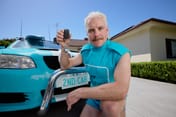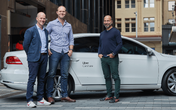
How much does a car wrap cost?
What's car wrapping and how much does it cost? Our guide will introduce you to this increasingly popular technique for giving your car a unique wow-factor.
If you think of car wrapping as a showroom salesperson putting a big bow on a brand new car to delight the new owner, it’s time to think again.
Car wrapping is the practice of applying a smooth and thin layer of vinyl over a vehicle’s paint. You can wrap just one section of a car, like a bonnet or roof, or an entire vehicle can be wrapped.
While the cost to wrap a car is not insignificant, there are several reasons that prompt people to choose to wrap their car:
| Prompts | Reasons |
|---|---|
| Look | Cars come in a relatively set range of colours, whereas wraps are available in a huge range of single colours and patterns. They can be custom designed with images, patterns and logos. You can get colour-shift and holographic wraps that look awesome on curved surfaces, as well as chrome wraps for the ultimate shine, We’ve even seen glow-in–the-dark wraps that look white during daylight and change to a glowing colour at night! |
| Feel | Wraps also come in different finishes, including light-capturing matte, smooth stain and shiny gloss. Some even have a 3D texture within the wrap. Some wraps will look very similar to regular paint whereas different textures will really make your car stand out in a crowd. The car wrapping cost will be higher if you choose these finishes. |
| Branding | You can paint your car with your logo or affix a decal or magnetic sign. Or, for amazing vehicle branding, you can cover your entire car in your colours, logos and images that wow others on the road. |
| Protection | As well as being durable, vinyl wraps are resistant to scratches and discolouration. So, not only is a wrapped car easier to maintain, the covering protects the original paint underneath. If you like your car’s colour and paint, it’s possible to wrap your car with a clear proactive cover only. |
| Versatility | Car wraps can be removed without affecting the underlying paint, meaning that a business car can morph back into a personal vehicle, or the one car can be re-branded to suit an evolving business. |
How long has car wrapping been ‘a thing’?
Car wrapping has been around for nearly a century, with some attributing the pioneering of the technique to 1926. Back then, car wrapping cost a huge amount so was only accessible to a few individuals and businesses. The idea of using vinyl lettering (instead of paint) to advertise a business on a car grew in popularity from the 1950s to 1990s.
Wikipedia tells us that a shift to full-vehicle wrapping happened in Germany in the early 1990s when a taxi company used car wrapping to allow drivers to adhere to the law that ruled all taxis had to be beige while protecting the cars’ original colour underneath so they could be sold once they’d finished their time as a taxi.
More recently, car wrapping has been growing in popularity since 2017, a time when technology started allowing a huge range of colours, finishes and cutting-edge design practices.
What’s involved in wrapping a car?
The first step is to choose an installer and then enjoy selecting your wrap. Many installers will do this on a 1:1 basis as every wrap is different. They’ll also look carefully at the condition of your car as existing damage can limit the effectiveness of a wrap.
Any individualization or unique requests will be noted at this time and there might be the next step of design work being undertaken and approved.
Once the installer is ready to start, they will clean your car’s exterior meticulously to ensure an ideal surface. Some wraps come pre-cut to fit each section of the car exactly and other installers will remove the lights and bumper bars so that the vinyl is seamless once they are reinstalled.
The vinyl wrap is then applied using a heat gun to warm each section so it becomes flexible for an ideal fit. Huge skill is used to scrape the vinyl so all air bubbles are removed and you’re left with a totally smooth surface.
A simple, partial car wrap can happen in a day. Full cars with harder-to-work wrap options might take several days.
Could you simply buy the vinyl and wrap it yourself? Technically, yes, but if ever covered a book in contact, you’ll know even on a small scale that misalignments and bubbles are hard to avoid. Scale that up to full size and, unless you’re an expert installer, your car is likely to end up looking wrinkly rather than shiny.
I’m keen! How much does it cost to wrap a car?
How much does it cost to wrap a car in Australia? The cost of wrapping varies depending on the:
- Size of your car
- Complexity of your car’s body
- Quality and type of the vinyl wrap
- Expertise of the installers.
Some installers, particularly higher-end outfits, prefer not to give standard estimates. Instead, they encourage you to make contact for a custom quote.
We love this price guide from car wrapping specialists, Pro Vinyl, which gives helpful ballpark figures for full car wraps:
| Type of Car | Price | |||
|---|---|---|---|---|
| Small car | from $2900 | |||
| Medium sedan | from $3300 | |||
| Sports coupe | from $3500 | |||
| Super sport | from $4000 | |||
| Large sedan | from $4200 | |||
| Wagon | from $4400 | |||
| 4WD | from $4800 | |||
| Large 4WD | from $5100 | |||
| Extra for cars with body kits | $90 |
These car wrap costs are estimates, with Pro Vinyl noting that a full wrap using a standard gloss might cost $3500 but the same car wrapped in a chrome vinyl would cost $6500.
So, in summary, the answer to the question ‘How much does a car wrap cost in Australia’ is between $3000 and $6000.
Pro Vinyl also has a guide for wrapping individual car parts - for example, a panel for $420-490 and a spoiler for $400.
If you’re wondering how the cost to wrap a car would fit in terms of the overall cost of owning and running a car, see our complete guide to car costs.
Anything else I should know?
Though car wrapping is legal across Australia, it’s worth noting that car colour is used as an identifying feature of a car along with its licence plate and VIN. So, if you are completely changing the colour of your car, you may need to notify both your insurance company and your state’s car registration authority.
What does car wrapping mean for my Uber Carshare?
Car wrapping that is plain coloured or patterned can both help protect your Uber Carshare and make it stand out from the crowd.
You can rent out a car through Uber Carsharethat has a car wrap with branding for another business or wrapped with advertising that’s an extra way to make money, however, we have found that borrowers are less likely to book this car, especially if others are equally available nearby.
A small form of car wrapping is the stickers that are available from Uber Carshare to help let others on the road know about your car. For example, we offer bumper stickers inviting people to ‘Borrow my car’, welcome stickers, and logo stickers. We also have stickers specifying that all cars are smoke-free and instructions about how to refuel the car.
So, that’s a wrap?
Yes! We hope you’ve enjoyed this overview of car wrapping, including the cost, and that it’s helped you consider whether wrapping might be a way to take your car to the next level.
FAQs
How much is a wrap for a car?
To wrap a whole car, estimates range between $2000 and upwards of $6000 for bigger cars or more expensive wraps. You can also wrap just one section of the car for a few hundred dollars. Additional costs are incurred for the design of custom-made wraps, including branding for business vehicles.
Is a wrap cheaper than paint car?
A good-quality paint can cost between $3000 and $10,000. Car wraps usually cost between $2000 and $6000. So, on average, a car wrap is cheaper than repainting a car.
How long does a car last wrapped?
An expertly-applied, high-quality wrap can last up to 10 years and even more if the car is garaged rather than being exposed to the elements.
Is it better to wrap or paint a car?
Car wraps are not only cheaper than painting, they are more durable, require less cleaning and polishing, and allow more flexibility for change later on.
Do wraps damage paint?
A well-wrapped car using high quality materials can be removed without any damage to the original paint.
What are the pros and cons of wrapping a car?
The main drawback of wrapping a car is the cost, which can range from a couple of thousand dollars to six thousand (or even more for complex wraps). The other drawback is a short-term one - that your car will be off the road for a couple of days while the wrap is applied. The pros of wrapping a car is the amazing look, low maintenance, protection of the underlying paint and the ability to remove the wrap down the track, whether for sale or design reasons.
Information included in this article is accurate as of 19 Dec 2022.The information published on this blog is of a general nature only and does not consider your personal objectives, financial situation or particular needs. The information published on this site/page should not be relied upon as a substitute for personal financial or professional advice.








